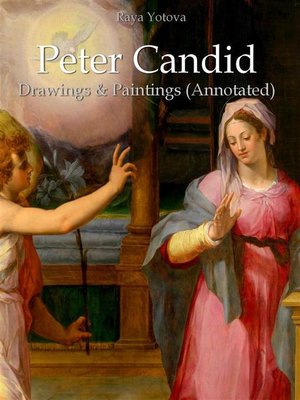
Sign up to save your library
With an OverDrive account, you can save your favorite libraries for at-a-glance information about availability. Find out more about OverDrive accounts.
Find this title in Libby, the library reading app by OverDrive.



Search for a digital library with this title
Title found at these libraries:
| Library Name | Distance |
|---|---|
| Loading... |
Peter Candid was born in Bruges in a family of a Flemish tapestry artist. His father moved to live and worked in Florence, Italy, when Little Peter was 10, so the artist's entire career was outside his native Holland.
He studied the art of painting at first with his father who was a tapestry weaver, then with an artist from the guild in Florence, where the Italians began to call him 'Candido' in translation of "de Witte", which means 'white'; later, when he began working in Germany, his family spoke and wrote "Candid" by analogy with the Italian 'Candido'.
In Florence, the young artist built himself as a professional and received his first orders from the Medici family, which marked the beginning of his glory and success in Europe.
In the mid-70s, Peter Candid was already a member of the Florence Academy of Arts, alongside with such glorified names as Michelangelo Bounarotti, Agnolo Bronzino and Benvenuto Cellini. From here his career only went up. He was summoned by Giorgio Vasari to work on the frescoes in the Vatican's Papal Palace, after which he remained for a certain period in Rome and received many paid orders for church decorations and others for portraits of nobles and wealthy people. Then we see him as a courtier artist of Maximilian I of Bavaria and several other European rulers.
Since the early 17th century Peter Candid has won the name of the most famous artist in Germany, and he has managed to preserve his reputation for almost thirty years until his death in 1628.
He was an extremely versatile painter who has painted in many genres, ranging from altars and church decoration, portraits, mythological stories, to tapestries and miniatures.
His style as a whole may be characterized as Mannerism but with many individual peculiarities and influences of the Italian and Flemish schools. From the Italian school, Michelangelo and Vasari were the most influential over him.
During the mature years of his artistic career, the artist works mainly for the court of Maximilian I of Bavaria. There he set up a special school for making tapestries, which became one of the strongest and most brilliant in Europe, although he worked with a relatively small number of artists and weavers hired specifically by the Netherlands.
He studied the art of painting at first with his father who was a tapestry weaver, then with an artist from the guild in Florence, where the Italians began to call him 'Candido' in translation of "de Witte", which means 'white'; later, when he began working in Germany, his family spoke and wrote "Candid" by analogy with the Italian 'Candido'.
In Florence, the young artist built himself as a professional and received his first orders from the Medici family, which marked the beginning of his glory and success in Europe.
In the mid-70s, Peter Candid was already a member of the Florence Academy of Arts, alongside with such glorified names as Michelangelo Bounarotti, Agnolo Bronzino and Benvenuto Cellini. From here his career only went up. He was summoned by Giorgio Vasari to work on the frescoes in the Vatican's Papal Palace, after which he remained for a certain period in Rome and received many paid orders for church decorations and others for portraits of nobles and wealthy people. Then we see him as a courtier artist of Maximilian I of Bavaria and several other European rulers.
Since the early 17th century Peter Candid has won the name of the most famous artist in Germany, and he has managed to preserve his reputation for almost thirty years until his death in 1628.
He was an extremely versatile painter who has painted in many genres, ranging from altars and church decoration, portraits, mythological stories, to tapestries and miniatures.
His style as a whole may be characterized as Mannerism but with many individual peculiarities and influences of the Italian and Flemish schools. From the Italian school, Michelangelo and Vasari were the most influential over him.
During the mature years of his artistic career, the artist works mainly for the court of Maximilian I of Bavaria. There he set up a special school for making tapestries, which became one of the strongest and most brilliant in Europe, although he worked with a relatively small number of artists and weavers hired specifically by the Netherlands.







